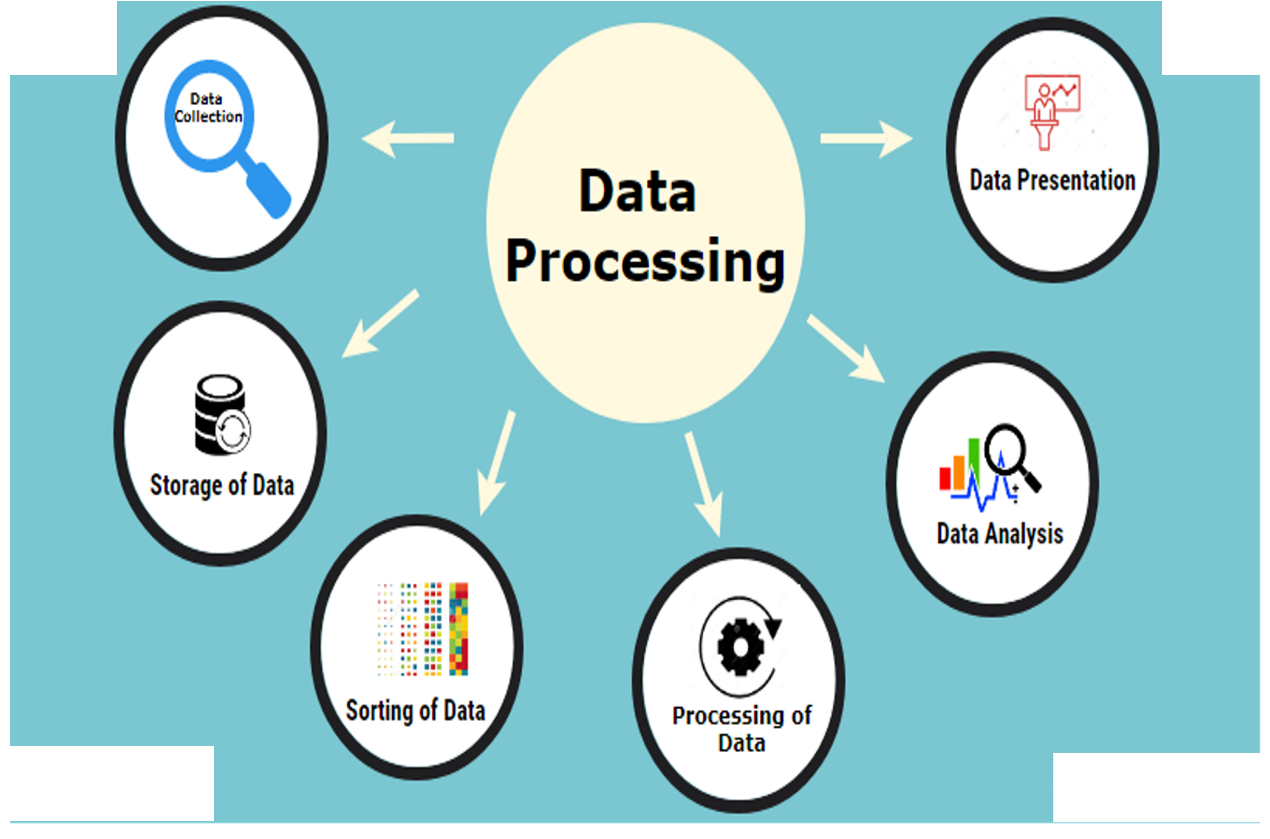What is Data Processing?
Data processing is simply the conversion of raw data to meaningful information through a process. Data is technically manipulated to produce results that lead to a resolution of a problem or improvement of an existing situation.
Similar to a production process, it follows a cycle where inputs (raw data) are fed to a process (computer systems, software, etc.) to produce output (information and insights).

A few examples:
- A shop asking customers to fill in an answer slip processes data.
- A hotel offering the possibility of online reservation also processes data if it requires guest names, the dates of their stay and their credit card number.
How Data is Processed?
Data processing starts with collecting data.The data collected to convert the desired form must be processed by processing data in a step-by-step manner such as the data collected must be stored, sorted, processed, analyzed and presented.
So this broadly divided into 6 basic steps as following discussion given below:

 The logically related data is collected from the different sources, different format, different types like from XML, CSV file, social media, images that is what structured or unstructured data and so all.
The logically related data is collected from the different sources, different format, different types like from XML, CSV file, social media, images that is what structured or unstructured data and so all.
 The collected data now need to be stored in physical forms like papers, notebooks and all or in any other physical form.Now because of the data mining and big data, the collection of data is very huge even in structured or unstructured form.The data is to be stored in digital form to perform the meaningful analysis and presentation according to the application requirements.
The collected data now need to be stored in physical forms like papers, notebooks and all or in any other physical form.Now because of the data mining and big data, the collection of data is very huge even in structured or unstructured form.The data is to be stored in digital form to perform the meaningful analysis and presentation according to the application requirements.
 After the storage step, the immediate step will be sorting and filtering.The sorting and filleting are required to arrange the data in some meaningful order and filter out only the required information which helps in easy to understand visualize and analyze.
After the storage step, the immediate step will be sorting and filtering.The sorting and filleting are required to arrange the data in some meaningful order and filter out only the required information which helps in easy to understand visualize and analyze.
 A series of processing or continuous use and processing performed on to verify, transform, organize, integrate, and extract data in a useful output form for farther use.
A series of processing or continuous use and processing performed on to verify, transform, organize, integrate, and extract data in a useful output form for farther use.
 Data analysis is the process of systematically applying or evaluating data using analytical and logical reasoning to illustrate each component of the data provided and to get the concluded result or decision.
Data analysis is the process of systematically applying or evaluating data using analytical and logical reasoning to illustrate each component of the data provided and to get the concluded result or decision.
 Once we come to the analysis result it can be represented into the different form like the chart, text file, excel file, graph and so all.Single software or a combination of software can use to perform storing, sorting, filtering and processing of data whichever feasible and required.It may be carried out by specific software as per the predefined set of operations according to the application requirements.
Once we come to the analysis result it can be represented into the different form like the chart, text file, excel file, graph and so all.Single software or a combination of software can use to perform storing, sorting, filtering and processing of data whichever feasible and required.It may be carried out by specific software as per the predefined set of operations according to the application requirements.
Different Types of Output
- Plain text file – These are exported as notepad or WordPad files. These are the simplest form of the data file.
- Table/ Spreadsheet – In this file format, the data represent in rows and columns, which help in easy understanding and analysis of data. This file format to perform various operations like filtering & sorting in ascending/descending order and statistical operations as well.
- Graphs and Charts – The graphs and charts format is standard features in most of the software. This format is very easy to analyze the data, not required to read each numeric data which takes a time consuming only in one look can understand and analyze the data.
- An Image File or Maps/Vector – If the application required to store and analyze with spatial data the option to export the data into image file and maps file or vector files is of great use.
- Along with these, the other format can be software specific file formats which can be used and processed by specialized software.
Conclusion
Now a day’s data is more important most of the work are based on data itself, so more and more data is collected for different purpose like scientific research, academic, private & personal use, commercial use, institutional use and so all. It is necessary to process this collected data so that all the above – mentioned steps are used for the processing which is stored, sorted, filtered, analyzed and presented in the required usage format.
The time consuming and complexity of processing depends on the results which are required. In the case of huge data collection or the big data the need for processing to get the optimal results with the help of data mining and data management it becomes more and more critical.


